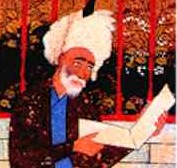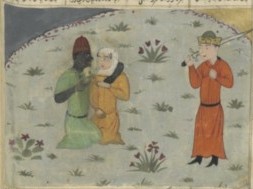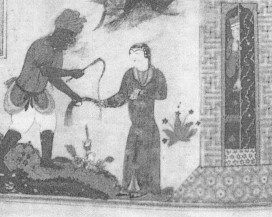


To next page
Amir Khusrau : I'jaz-i-Khusravi
(1283) (Self Elevation) Delhi, India
------------------------------------------------------
Taken from: Society and Culture in Medieval India, By A. Rashid
Dr. Zakir Husain Presentation Volume: Presented on His Seventy First
Birthday by Zakir Husain
Medieval India by Aligarh Muslim University
The book contains five manuals on the art of writing prose and poetry and including some of his early letters to his friends. The first four manuals were compiled in 683 A.H./1283 A.D. and the last in 720 A.H./1320 A.D.
The traders of the port of Kambhayet, who are so opulent and active on the sea, have brought some precious things (nafais) by sea for the imperial treasury and they should give their delivery to the Mutasarrifs (revenue officers) of Naharwala. They constantly ply their vessels on the waters of those directions and the rarities of Maghrib and Sham (Syria) reach continuously and in succession to this side. They should take their vessels to Jerusalem (Bait-ul-Maqaddas) and bring them back. The other merchandise, carried in their vessels from Ethioipia and Barbari, include the black slaves of Abyssinia (Barda-i-Habashi) whose services are utilized in guarding the harem and as soldiers. Their salty black colour is attractive in its own way. The negro slaves of Zanjbar (Zanzibar) (Ghulaman-i-Zang) and Darya (?) are of gigantic size and very swift-footed. They were all recipients of royal favours.
(another translation also has:) They were ebony-colored, and had curly and twisted hair on their heads. The large-eyed female slaves of habsh were of agreeably saltish black color. They ran so fast like giants that even the shooting stars in the atmosphere could not keep pace with them They were quick-tempered. When they applied collyrium to their eyes blood seemed to ooze out of them.
---------------------------------------------------------------------------------------------------
Amir Khusru : Tarikh-i 'Alai or Khazainu-L Futuh (1325)Delhi
Taken from : Elliot : The history of India as told by its own Historians vol 3
A farman was issued by Sultan Alau-d din that the surviving prisoners should be massacred, and beaten up into mortar for the fort.
They hung down from the Tatari and Chini fortress,
As Abyssinians with heads inverted hang from a new building;
And a bastion was formed from an hundred thousand of heir heads.
------------------------------------------------------------------------------------------------
Husraw Dihlavi, Hasht Bihisht (1302)
Taken from; website of the French national Library
Hasht Bihisht (lit. Eight Paradises) written by Amir Khusro around 1302 AD. It is based upon an earlier epic poem, the Shahnameh written by Firdausi around 1010 AD and a later adaptation, the Haft Paykar by Nizami, written around 1197 AD. The Shahnameh is a very long work spanning many ages of Persian history. Khusro's Hasht Bihisht retells just a small portion of the life of Bahram V Gur and embellishes the original historical but glorified tales with other non-historical elements.


The second descends to a camel drover, who drags her to the ground by the hair, and beds her on thorny camel fodder.
The third lady leaves; crosses the river and goes to a Hindu who has been waiting for her.
The fourth one is a pious woman.